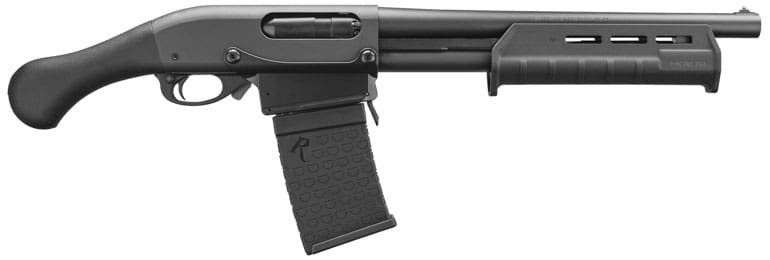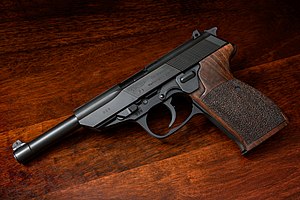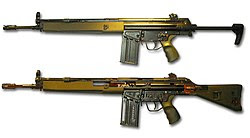



Now I am sure that this pistol shoot like a dream. Just because it’s a Anschutz! Plus the 17 HMR is one very accurate round.
But I got to say, that it is one of the oddest looking guns that I have ever seen in over 50 years of shooting!
Category: All About Guns
The Vickers Machine Gun Youtube
New Remington Shotgun
Remington Announces New Line of 870 DM Magazine-Fed Shotguns

courtesy Kat Ainsworth

Their new line of magazine-fed 870 DM (detachable magazine, in case you couldn’t decipher that) ships with a single six-round mag giving you seven rounds of quickly re-loadable, heavy hitting firepower — pretty handy to have in a home defense scattergun. And they’re making the DM’s in five different flavors . . .

870 DM (81350)
- 6 Round Detachable Magazine
- Black Synthetic Stock with Super Cell Recoil Pad
- Tactical “Corn Cob” Forend
- 18.5 Inch Fixed Cylinder Bore Barrel
- MSRP – $529.00

870 DM Magpul (81352)
- 6 Round Detachable Magazine
- Magpul SGA Stock with Super Cell Recoil Pad
- Magpul MOE M-LOK Forend
- 18.5 Inch Rem Choke Barrel with Extended Ported Tactical Choke
- XS Steel Front Sight, XS Tactical Rail/Ghost Ring Rear Sight
- MSRP – $799.00

870 DM Tactical / Predator (81354)
- 3 and 6 Round Detachable Magazines
- Over Molded ShurShot Thumbhole Stock with Super Cell Recoil Pad
- Tactical “Corn Cob” Fore-end
- 18.5 Inch Rem Choke Barrel with two Trulock Extended Chokes (Boar Blaster and Turkey /Predator)
- XS Steel Front Sight, XS Tactical Rail/Ghost Ring Rear Sight
- Kryptek Highlander Camo
- MSRP – $799.00

870 DM Hardwood (81351)
- 6 Round Detachable Magazine
- Hardwood Stock and Fore-end
- 18.5 Inch Cylinder Bore Barrel
- Bead Sight
- MSRP – $529

870 DM Tactical (81360)
- 6 Round Detachable Magazine
- Pistol Grip Buttstock and Tactical “Corn Cob” Fore-end
- 18.5 Inch barrel with Extended Ported Tactical Choke
- XS Steel Front Sight, XS Tactical Rail/Ghost Ring Rear Sight
- MSRP – $799
But wait…there’s more! Remmy’s also added magazine capacity to their non-NFA Tac-14 non-shotgun shotgun . . .

870 DM Tac-14 (81348)
- 6 Round Detachable Magazine
- Shockwave Grip and Magpul Fore-end
- 14 Inch Cylinder Bore barrel
- Bead Sight
- MSRP – $559
I shot a prototype version and while it was slightly stiffer to rack than a standard 870, it cycled flawlessly. Look for our review soon.

List of battle rifles
Below is the list of battle rifles. The table is sortable for every column.
Whitworth rifle




Whitworth rifle
| Whitworth rifle | |
|---|---|
 |
|
| Type | Rifled Musket |
| Place of origin | United Kingdom |
| Service history | |
| Used by | Confederate States of America |
| Wars | American Civil War |
| Production history | |
| Designer | Joseph Whitworth |
| Designed | 1854-1857 |
| Manufacturer | Whitworth Rifle Company |
| Produced | 1857-1865 |
| No. built | 13,400 |
| Specifications | |
| Length | 49 in (1,200 mm) |
| Barrel length | 33 in (840 mm) |
|
|
|
| Cartridge | .451 caliber bullet |
| Caliber | 0.451 in (11.5 mm) |
| Action | muzzle loaded |
| Rate of fire | 2–3 rounds per minute |
| Effective firing range | 800 to 1,000 yd (730 to 910 m) |
| Maximum firing range | 1,500 yd (1,400 m) |
| Feed system | muzzle loader |
The Whitworth Rifle was a single-shot muzzle-loaded
Contents
[hide]
History[edit]
The Whitworth rifle was designed by Sir Joseph Whitworth, a prominent British engineer and entrepreneur. Whitworth had experimented with cannons using polygonal rifling instead of traditional rifled barrels, which was patented in 1854. The hexagonal polygonal rifling meant that the projectile did not have to bite into grooves as was done with conventional rifling. In 1856, this concept was demonstrated in a series of experiments using brass howitzers.
Whitworth believed that the same type of system could be used to create a more accurate rifle to replace the Pattern 1853 Enfield, which had shown some weaknesses during the recent Crimean War. Trials were held in 1857 to compare Whitworth’s design against the Enfield. The Whitworth rifle outperformed the Enfield at a rate of about three to one in the trials, which tested the accuracy and range of both weapons. Notably, the Whitworth rifle was able to hit the target at a range of 2,000 yards, where the Enfield was only able to hit the same target at a range of 1,400 yards.[1]
While the trials were generally a success for the Whitworth rifle, the British government ultimately rejected the design because the Whitworth’s barrel was much more prone to fouling than the Enfield, and the Whitworth rifle also cost approximately four times as much to manufacture. The Whitworth Rifle Company was able to sell the weapon to the French army, and also to the Confederacy during the American Civil War.
Design and features[edit]
While the barrel design of the Whitworth rifle was innovative, the rest of the rifle was similar to other rifles and rifle-muskets used at the time. The rifle was muzzle loaded, and used a percussion lock firing mechanism. The lock mechanism was very similar to that used on the Enfield rifle-musket.
Whitworth chose to use a longer and more slender bullet than was common at the time, which resulted in a bore diameter of .451 caliber, significantly smaller than the Enfield’s .577 caliber bore. Whitworth’s bullets were more stable at longer ranges than the shorter and larger diameter bullets found in other rifles of the time. Whitworth also engineered the barrel with a 1-in-20″ twist, quite a bit tighter than the 1-in-78″ of the 1853 Enfield, or the later 1856/1858 variants with 5 groove barrels and a 1-in-48″ twist. The extra spin the faster twist imparted to the projectile further stabilized the bullet in flight.
The Whitworth rifle weighed 9 pounds. Other long range rifles of the period tended to have much larger and heavier barrels, which made them too heavy for standard infantry use.
Whitworth rifles, being used by sharpshooters, were usually rested against a tree or log while fired to increase their accuracy. Some sharpshooters carried their own forked rests for the rifle, so that a suitable rest was always available.[2]
Use[edit]
In 1860, the British National Rifle Association held its first annual meeting at Wimbledon. Queen Victoria fired the first shot from a Whitworth rifle on a machine rest at 400 yards, and struck the bull’s-eye 1-1/4 inch from its center.[3]
Britain was officially neutral during the American Civil War; however, private arms manufacturers were not required to remain neutral. The Whitworth Rifle Company, for example, sold the rifle to the Confederacy. The Confederate soldiers that used these rifles were referred to as Whitworth Sharpshooters. They accompanied regular infantrymen, and were usually used to eliminate Union artillery gun crews.
According to popular accounts, on May 9, 1864, during the Battle of Spotsylvania Courthouse, Union General John Sedgwick was chiding some of his troops for lying down in a ditch to avoid Confederate sharpshooters at a range of around 800 to 1000 yards. Shots from Confederate Whitworth rifles, easily identifiable due to the shrill whistling noises their hexagonal bullets made in flight, caused members of his staff and artillerymen to duck for cover. Sedgwick strode around in the open and was quoted as saying, “What? Men dodging this way for single bullets? What will you do when they open fire along the whole line? I am ashamed of you. They couldn’t hit an elephant at this distance.” Although ashamed, his men continued to flinch and he repeated, “I’m ashamed of you, dodging that way. They couldn’t hit an elephant at this distance.” Just seconds later he fell forward with a bullet hole below his left eye. At least five Confederate soldiers would later claim that they had fired the fatal shot.
Earlier during the war, the Whitworth was responsible for another high-ranking death. On Sept 19, 1863, at the Battle of Chickamauga, an unnamed Confederate sharpshooter mortally wounded Union General William Lytle, who was leading a charge at the time.[citation needed]
Variants[edit]
Whitworth rifles were made with barrel lengths of 33, 36, and 39 inches, giving the weapon an overall length of 49, 52, and 55 inches respectively.[4] The barrel was attached to the stock using two or three barrel bands, depending on the barrel’s length.
Two types of bullets were used in the Whitworth rifle, hexagonal and cylindrical. The cylindrical bullets had a small hollow base which would expand and grip the hexagonal sides of the barrel, which required that the bullets be made out of very soft lead. The cylindrical bullet, however, easily upsets into the hexagonal bore under the influence of the explosion of the charge of between 80 and 90 grains of fine rifle powder used for this particular firearm – recovered bullets fired from a Whitworth rifle are as hexagonal as their factory-made counterparts. The hexagonal form bullet did not need to expand to properly grip the barrel, and therefore could be made out of a harder alloy than pure lead.[5]
The sights used on Whitworth rifles varied. Some used Enfield type flip up sights that were graduated to 1,200 yards in 100 yard increments. Others used a sliding blade sight with an adjustment for windage. Some had simple fixed front sights, while others used a post and globe front sight. A small number of Whitworth rifles were equipped with a four power telescopic sight, designed by Colonel Davidson which, unlike modern rifle scopes, was attached to the left side of the weapon instead of the top. While the telescopic sight was very advanced for its time, it had a reputation for leaving the user with a black eye due to the rifle’s fairly substantial recoil.
The typical Confederate rifle in the U.S. Civil war had a barrel length of 33 inches, open sights with the front blade being adjustable for windage, and a stock which extended to within a short distance of the muzzle, giving the rifle a snub-nosed appearance.
Modern use[edit]
Modern reproductions of Whitworth rifles were manufactured by Parker-Hale and Euroarms, the Italian manufacturer Pedersoli has begun the production of these rifles in September 2015. These rifles are used by Civil War re-enactors and those who have an interest in 19th century firearms, however the Civil War military variants were all “2-band” with 33″ barrels, while the reproduction rifles made as of 2017 are all the longer barreled, “3-band”, civilian versions of the famed rifle . Many riflemen enjoy using these rifles in target shooting competition at ranges up to 1,000 yards.
References[edit]
- Jump up^ “Minutes of proceedings of the Institution of Civil Engineers, Volume 19” By Institution of Civil Engineers (Great Britain)
- Jump up^ “Through the Crosshairs: A History of Snipers” By Andy Dougan
- Jump up^ “The gun and its development” By William Wellington Greener
- Jump up^ “U.S. and Confederate Arms and Armories During the American Civil War: Arms imported from Europe during the American Civil War, 1861-1865” By James P. Whisker
- Jump up^ “Gunshot injuries, their history, characteristic features, complications, general treatment” By Sir Thomas Longmore
German Pistol Porn
Will somebody please explain to me. On why German Guns just look meaner and deadlier than almost any other gun?













Jeremy Clarkson & Guns

One of my many Vices is that of watching Top Gear and The Grand Tour by the Guys. I also think that Clarkson is my kind of guy as he punched out Piers Morgan.
Anyways he did some really good Videos about Guns and War. So I hope you might like them!
http://www.dailymotion.com/video/x194p8_top-gear-prius-test-shooting-by-gu_auto

So far I have had a lot of good luck with Sako. Having either owned or shot about a dozen of their rifles. My only complaints are that they are hard to find to buy and are costly too! Oh well.





Winchester 490 in 22LR
Just another reason on why Ruger beat the pants off of Winchester in the 22 Semi Auto market. I.E. Too little & too late! Nonetheless it’s a nice little gun in its way!



As you can see the rotary magazine of the 10/22. Helps preserve the clean lines that this gun does not have with the extended magazine. Also it will not snag on things either when carrying it.













.40-65 Winchester
| .40-65 Winchester | ||||||||||||||||
|---|---|---|---|---|---|---|---|---|---|---|---|---|---|---|---|---|
| Type | Rifle | |||||||||||||||
| Place of origin | USA | |||||||||||||||
| Specifications | ||||||||||||||||
| Bullet diameter | .406 in (10.3 mm) | |||||||||||||||
| Neck diameter | .423 in (10.7 mm) | |||||||||||||||
| Shoulder diameter | .560 in (14.2 mm) | |||||||||||||||
| Base diameter | .504 in (12.8 mm) | |||||||||||||||
| Rim diameter | .604 in (15.3 mm) | |||||||||||||||
| Case length | 2.1 in (53 mm) | |||||||||||||||
| Overall length | 2.48 in (63 mm) | |||||||||||||||
| Rifling twist | 1:20 to 1:26 | |||||||||||||||
| Primer type | large rifle | |||||||||||||||
| Ballistic performance | ||||||||||||||||
|
||||||||||||||||
| Source(s): Barnes & Amber | ||||||||||||||||
The .40-65 Winchester (also called the .40-65 Winchester and Marlin)[1] was an American rifle cartridge.
Introduced in 1887 for the Winchester Model 1886, and available in Winchester single shots and in the Marlin Model 1895, it was “a further effort to put more steam” in repeating rifle cartridges.[2]
In the modern era, the cartridge has gained favor for metallic silhouette shooting and Black Powder Cartridge Rifle matches where is serves as a low-recoil alternative to the common 45-70.[3][4]
It was commercially available in black and smokeless varieties until around 1935, and can be handloaded by reforming .45-70 brass.[2]
Nomenclature
The nomenclature of the period was based on several properties of the cartridge:
- .40: nominal caliber in inches: 0.40 inches (10.2 mm); actual caliber was .406 in ( mm)[5]
- 65 : weight of propellant (black powder) charge, in grains: 65 grains (4.2 g)


































